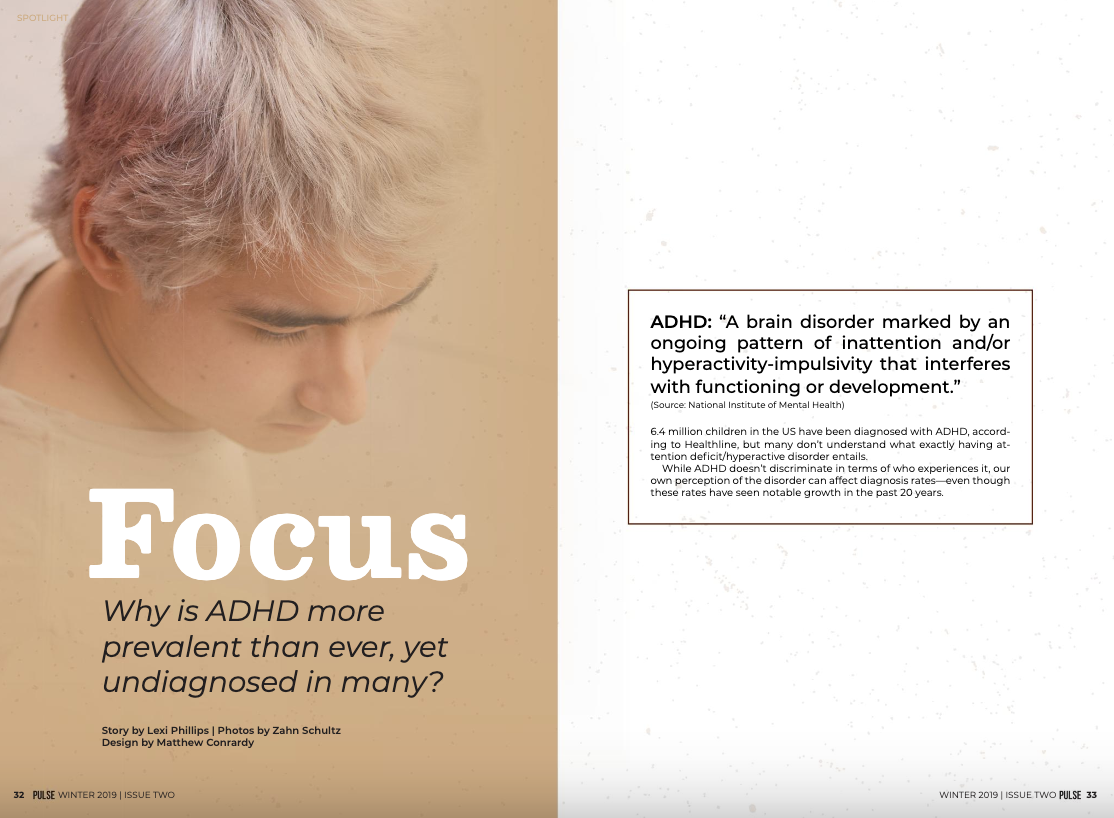Focus: Why is ADHD more prevalent than ever, yet undiagnosed in many?
Story by Lexi Phillips | Photos by Zahn Schultz | Design by Mathew Conrardy
ADHD: “A brain disorder marked by an ongoing pattern of inattention and/or hyperactivity-impulsivity that interferes with functioning or development.” (Source: National Institute of Mental Health)
6.4 million children in the US have been diagnosed with ADHD, according to Healthline, but many don’t understand what exactly having attention deficit/hyperactive disorder entails.
While ADHD doesn’t discriminate in terms of who experiences it, our own perception of the disorder can affect diagnosis rates—even though these rates have seen notable growth in the past 20 years.
The ADHD Association
The stereotypical vision of ADHD is simple: a child bouncing off the walls, energy boundless and attention sporadic; a friend who stops mid-sentence to point out a shiny object.
This idea is often portrayed in the media and has shaped our view of ADHD, but it is not necessarily an accurate representation of what, according to the Center for Disease Control, over six million children in America experience.
Gender Disparity
Elizabeth Bailey, a senior theatre production and design major at CWU with ADHD, says that this portrayal can even be harmful. “It’s not the whole picture. People who have ADHD can sit really calmly in class and look like they’re focused and they’re not; they’re nowhere present,” she says. “So then, because they don’t have that hyperactivity, you start to devalue their diagnosis.”
Because of this, women and girls are less likely to be diagnosed with ADHD.
“Females … tend to suffer more of the inattentive symptoms versus the hyperactive,” says Dr. Heath Marrs, a professor of psychology and director of the school psychology program at CWU. “In kids, if you just have the inattentive symptoms, you’re not going to get noticed as much.”
In an article titled, “The Hidden Struggles of a Woman with ADHD” for Healthline, Elaine Atwell wrote,
“This means people frequently write our inattention off as a character flaw, rather than a treatable condition.”
The same is true for Maria Sanders, an associate professor and director of CWU’s film program. Upon diagnosis, which didn’t happen until her 30s, Sanders says she felt “a lot of relief because when I looked at the difficulties I was having, I basically blamed it on being a personal failure.” She thought, “‘I’m lazy. I’m disorganized. I should be better at X, Y or Z,’ without realizing that my brain functions in a certain way and that might not be my fault.”
Getting Older
The other side of that stereotype, of course, is the child. It is believed by many, according to Marrs, that ADHD goes away with age.
“Sometimes people think as a kid you’re maybe hyperactive or struggle with attention but as an adult, you should grow out of it, and that’s not the case,” says Marrs. “We know that there is adult ADHD. And there are a lot of adults with ADHD who learn to manage it better, but they still have the ADHD and they struggle with it.”
Even though adults with ADHD often don’t show the more common symptoms of inability to study or hold still, for example, it doesn’t mean their ADHD has somehow gone away, says Dr. Jeffrey Penick, an associate professor of psychology at CWU.
“The symptoms do change across life stages, and some of that has to do, literally, with the tasks we do,”
says Penick.
For Sanders, having ADHD meant that being on the tenure track was a more difficult process. “When you’re on the tenure track as a professor, you have a certain amount of creative or scholarly work that you have to produce within a window of time, six years usually,” she says. “So, the problem with that for somebody who has ADHD is that while there’s one giant deadline—and they do want you to show that you’re making progress—it’s not a fixed deadline.”
Sanders explains that because of this system, self-motivation is key. “A lot of people with ADHD have difficulty with motivation unless there’s an instant gratification that comes from it,” she says.
Racial Bias
But it’s not only adults and women who face this issue. People of color—namely, African American and Latinx people—are less likely to be diagnosed with ADHD. A 2018 study conducted by the Journal of the American Medical Association (JAMA) found that of the 186,457 children and adolescents who had been diagnosed with ADHD, 61.3 percent were non-Hispanic white, 15.8 percent were non-Hispanic black and 17 percent were Hispanic.
“One of the reasons would be access to healthcare,” says Dr. Krystal Letourneau, a psychologist at Brain and Body Integration in Colorado Springs. “Minorities typically … approach mental health a little bit differently—Latino populations particularly—and they don’t usually seek mental health treatment for many years.” Dr. Letourneau adds that today’s issues with access to medical care only elevate the issue.
An article by ADDitude Magazine describes the experiences of Janel Dillard, an African American woman with ADHD. “Mental problems are considered ‘taboo’ in some communities. … Her family mostly viewed her situation as a lack of willpower, particularly in light of the difficult history of African Americans in the U.S.” Dillard added that because older generations of African Americans had ‘worse’ experiences in their day, later generations were more likely to have just “’dealt with it and moved on,’” she said.
The same article, though, theorizes that it could have something to do with the clinicians diagnosing them.
“As providers—like most Americans—we carry implicit biases,”
said Clinical Psychologist Natalie Cort in an interview with the magazine. “If you present two stimuli simultaneously, and you do it repeatedly, your brain—which wants to be efficient—will make an association [subconsciously] that when one stimulus is presented, the other one should come next.”
In other words, our internalized biases can result in subconscious prejudice. In a 1988 study, as explained by the article, “when presented with patients showing identical symptoms, [clinicians] overwhelmingly diagnosed black men with severe conditions, like schizophrenia, while diagnosing white men with milder conditions, like depression.”
30 years later, though, this study may turn out differently. That doesn’t change the fact that we still carry these implicit biases today. “’There is reporting that says health practitioners are more responsive to white and English-speaking families,’” said Dr. Paul Morgan, Pennsylvania State University professor of education and director of the Center for Educational Disparities Research, in the article. “’Minority families have reported that practitioners can be dismissive of their concerns for their child, or less likely to solicit developmental concerns.’”
The ADHD Age
Even though certain demographics are less likely to be diagnosed, overall diagnoses have increased significantly over the past two decades. According to the JAMA study, the amounts of children and adolescents in the US diagnosed with ADHD was 6.1 percent between 1997 and 1998 and 10.2 percent between 2015 and 2016.
The study concludes that further research is needed to determine why this is happening, but there are theories.
Dr. Letourneau points to today’s reliance on technology. “With the rise of technology has come a generation who doesn’t play outside as frequently,” she says. “This generation has a shorter attention span as we have constant entertainment at the tip of our fingers. … Now, we see short attention spans as ADHD when it may just be a reality for the following generations.”
Bailey adds that this can lead to the over-prescribing of Adderall.
“We live in a very stimulating society, and so it’s really easy to feel like you might have ADHD because of all of these distractions,”
she says. “But then when we over-prescribe Adderall or any other stimulant, the way that it affects a neurotypical brain is different than anybody with a condition that might need it more.”
The increase in diagnoses has followed the rise of pharmaceutical companies, proposes Dr. Letourneau. “Like every other disorder, these companies make medication and get paid very well for their product,” she says. “Unfortunately, that leads to a rise in complaints by citizens that these symptoms fit them.”
Dr. Letourneau alludes to ads for antidepressants, in which she says the symptoms listed can be very vague. “The same is happening with ADHD. Teachers, doctors [and] parents see other kids and think, ‘Oh, my child also struggles to complete homework. I should have them checked,’” she explains.
“More people asking for medication means more diagnoses are made.”
For a deeper look at the prevalence of Adderall use in college, read “The Adderall Age” in PULSE’s Fall 2016 Issue Two.
Lastly, the rise could be due to an increased awareness and acceptance of ADHD. Therapist Dr. Kimberly Finger says that because the overall stigma surrounding mental health has decreased, more people are seeking assistance for their mental health.
For Sanders, this awareness is what led her to being diagnosed. After she and her then-husband watched a documentary on ADHD, she explains, her then-husband pointed out that Sanders may have the disorder. “When he said that, I didn’t particularly feel judged,” she says. “He wasn’t saying it in a critical way; he was honestly asking because he recognized, in the people being portrayed in that documentary, a lot of my behaviors.”
Sanders adds, “I just think it’s important for people to have a support system, and also to know that once they let go of shame around their behavior, then they can be open to feedback that’s helpful.”



